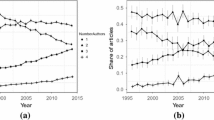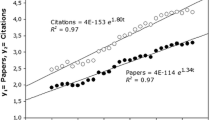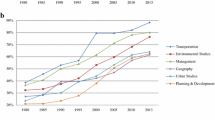Abstract
There have recently been completed a number of studies which analyse and interpret trends in multiple authorship for scientific papers. This paper presents data which show that a significant relationship exists between levels of multiple authorship for papers submitted to a leading Astronomy journal, and their frequency of acceptance for publication. It is argued that this finding indicates the need for the exercise of more extensive qualification when drawing inferences about actual social aspects of research activity, from trends in the multiple authorship of published papers.
Similar content being viewed by others
Explore related subjects
Discover the latest articles and news from researchers in related subjects, suggested using machine learning.Notes and references
D. de SOLLA PRICE,Little Science Big Science, Columbia Univ. Press, 1963, p. 87–89.
For example — B. L. CLARKE, Multiple authorship trends in scientific papers,Science, 143 (1964) 822–823; F. C. KULL, Publication trends in microbiology,Bacteriological Review, 29 (1965) 534–43; A. A. MAANTEN, Statistical analysis of a scientific discipline: palynology,Earth Science Reviews, 6 (1970) 181–218; J. G. O'CONNOR, Growth of multiple authorship,DRTC Seminar, 7 (1969) 463–483; M. SMITH, The trend toward multiple authorship in psychology,American Psychologist, 13 (1958) 596–599.
The most comprehensive attempt is by D. de B. BEAVER and R. ROSEN in a series of three papers: studies in scientific collaboration Part 1. The professional origins of scientific coauthorship,Scientometrics, 1 (1978) No. 1, 65–84; Studies in scientific collaboration Part 2; scientific co-authorship, research productivity and visibility in the French scientific elite 1799–1830,Scientometrics, 1 (1978) No. 2, 133–149; Studies in scientific collaboration Part 3. Professionalization and the natural history of modern scientific co-authorship,Scientometrics, 1 (1979) No. 3, 231–245. See also W. D. HAGSTROM, Traditional and modern forms of teamwork,Administrative Science Quarterly, 9 (1964) 241–263; andThe Scientific Community, Basic Books, N. Y, 1965 Ch. 3.
Many of the above, most notably MAANTEN. I. H. PAGE, Some perils of authorship,Science, 144 (1964) 137 presents an interesting editorial discussion of problems created by co-authorship trends.
Comparisons are drawn in O'CONNORop. cit. p. 473
A. J. MEADOWS,Communication in Science, Butterworths, 1974, p. 201.
MEADOWS,op. cit. Communication in Science, Butterworths, 1974, p. 200.
B. L. CLARKE, Communication patterns of biomedical scientists,Federation Proc., 26 (1967) 1288–92; W. HIRSCH, J. F. SINGLETON,Research support, multiple authorship and publications in sociology journals 1936–1964 (unpublished).
O'CONNOR,op. cit. MEADOWS, O'CONNOR, p. 473.
PRICE,op. cit. D. de SOLLA PRICE,Little Science Big Science, Columbia Univ. Press, 1963, p. 89–90.
MEADOWS,op. cit. Communication in Science, Butterworths, 1974, p. 204; A. J. MEADOWS, J. G. O'CONNOR, Bibliographic statistics as a guide to growth points in science,Science Studies, 1 (1971) 95–99.
PRICE,op. cit. D. de SOLLA PRICE,Little Science Big Science, Columbia Univ. Press, 1963, p. 89–90.
For example G. P. BUSH, L. H. HATTERY, Teamwork and creativity in researchAdministrative Science Quarterly, 1 (1956) 361–362. J. JEWKES et al.,The Sources of Invention, St. Maetins Press, N. Y. 1959.
MAANTEN,op. cit.
de B. BEAVER and ROSEN, Studies in Scientific collaboration, Parts I. II. III.,op. cit. Studies in scientific collaboration Part 1. The professional origins of scientific coauthorship,Scientometrics, 1 (1978) No. 1, 65–84; Studies in scientific collaboration Part 2; scientific co-authorship, research productivity and visibility in the French scientific elite 1799–1830,Scientometrics, 1 (1978) No. 2, 133–149; Studies in scientific collaboration Part 3. Professionalization and the natural history of modern scientific co-authorship,Scientometrics, 1 (1979) No. 3, 231–245.
See for example H. M. COLLINS, the Tea Set: tacit knowledge and scientific networks,Science Studies, 4 (1974) 165–186. D. EDGE, Quantitative measures of communication in science: a critical review,History of Science, 17/2 (1979) No. 36, 102–134. C. FREEMAN,Measurement of output of research and experimental development: a review paper. UNESCO statistical Reports and Studies, No. 16, UNESCO, Paris, 1969. G. N. Gilbert, Measuring the growth of science. A review of indicators of scientific growth,Scientometrics, 1, (1978), No. 1, 9–34.
D. EDGE,op. cit..
For a fuller exposition of patterns of evaluation associated with various author and referee variables see M. D. GORDONA study of the evaluation of research papers by primary journals in the U. K. PCRC publication University of Leicester, 1978, or M. D. GORDON, Refereeing reconsidered and examination of unwitting bias in scientific eveluation, in M. BALABAN (Ed.),Scientific Information Transfer: the Editor's Role, Reidel, Dordrecht, 1978, p. 231–235. See also: M. D. GORDON, Deficiencies of scientific information access and output in less developed countries,Journal of the American Society for Information Science, 30 (1976) No. 6, 340–342, for an analysis of the patterns of, and reasons for, rejecting papers submitted from differing nation groups.
MEADOWS,op. cit. A. J. MEADOWS,Communication in Science, Butterworths, 1974, p. 204.
Ibid. A. J. MEADOWS,Communication in Science, Butterworths, 1974,
Compare this observation with the argument of deB. BEAVER and ROSEN that co-authorship is a response to, and manifestation of, a process of professionalization dating back to the 17th century.
A. J. MEADOWS, J. G. O'CONNOR,A survey in depth of a selected information field (Astronomy and Astrophysics), Astronomy Department, University of Leicester, 1971.
Ibid. A. J. MEADOWS, J. G. O'CONNOR,A survey in depth of a selected information field (Astronomy and Astrophysics), Astronomy Department, University of Leicester, 1971.
For a discussion of the effects of these research resources upon patterns of social collaboration see D. EDGE, M. MULKAY,Astronomy transformed, the emergence of radio-astronomy in Britain, Wiley & Sons, London, 1966.
That this association has been observed cannot be taken to prove that a causal relationship exists. Indeed, PRICE (op. cit D. de SOLLA PRICE,Little Science Big Science, Columbia Univ. Press, 1963, p. 90.) has argued that ‘it is to some extent accidental that wartime organization and the advent of the big machine have occasioned the introduction of fractionality, without which we should have a severe (research) manpower shortage.’
Pulsars are sources of radio emission found in deep space. Their discovery was unexpected (and rewarded with a Nobel Prize) and it precipitated great interest throughout the space science community. It is important to note, however, that the observational and analytical parts of this work could only be engaged in by those with access to expensive, highly complex large scale radio telescopes, of which there were only a limited number. See MEADOWS, O'CONNOR,Science Studies, 1 (1971) 95–99 (op. cit.)
O'CONNOR,op. cit. MEADOWS, O'CONNOR,.
MEADOWS,op. cit. MEADOWS, O'CONNOR, p. 205.
U. K. universities were split into “major” and “minor” institutions on the basis of the former set standing apart from the latter in terms of levels of funding received from the British Science Research Council, and their perception as elite institutions by those in the field.
For example, timing of observation, range of electromagnetic spectrum observed etc.
The identification of these criteria is based on the reading of large numbers of refereeing forms, and corroborative discussions with editors and experienced referees.
For a discussion of the division of scientific labour and patterns of communication, collaboration and competition in this field see J. GASTON,Originality and competition in science: a study of the British High Energy Physics community, University of Chicago Press, 1973.
Author information
Authors and Affiliations
Rights and permissions
About this article
Cite this article
Gordon, M.D. A critical reassessment of inferred relations between multiple authorship, scientific collaboration, the production of papers and their acceptance for publication. Scientometrics 2, 193–201 (1980). https://doi.org/10.1007/BF02016697
Received:
Revised:
Issue Date:
DOI: https://doi.org/10.1007/BF02016697




